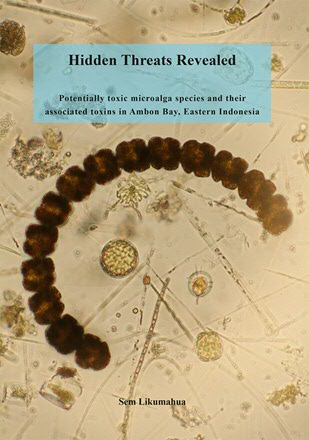Upcoming thesis defence on October 6, 2020: Hidden threats revealed - Potentially toxic microalga species and their associated toxins in Ambon Bay, Eastern Indonesia

On Tuesday the 6th of October, Sem Likumahua will defend his thesis 'Hidden threats revealed - Potentially toxic microalga species and their associated toxins in Ambon Bay, Eastern Indonesia'.
Since decades, Indonesia suffers from harmful algal bloom events, resulting in environmental, socio-economic and health problems. The dinoflagellate Pyrodinium bahamense var. compressum is a toxic phytoplankton species that has been found to form blooms and toxic events in Ambon Bay, eastern Indonesia. As a result of monitoring efforts, other potentially toxic phytoplankton species are also frequently detected. However, information regarding toxin composition and dynamics were lacking for Ambon Bay as well as for Indonesia at large. The present study was aimed to investigate dynamics of toxic phytoplankton species and their associated toxins in conjunction with environmental drivers in Ambon Bay. The results revealed several toxic phytoplankton species such as Pseudo-nitzschia spp., Alexandrium spp., Gymnodinium catenatum, and Dinophysis spp. as well as their associated toxins. Further dinocyst analyses revealed high abundances of Polysphaeridium zoharyi (cysts of the toxic Pyrodinium bahamense) in the inner part of Ambon Bay. This region receives massive allochthonous organic matter and major nutrients (N and P) via runoff, which fuel high productivity and promote (toxic) harmful algal blooms. Generally, toxic phytoplankton showed species specific responses to a range of environmental drivers. Yet, factors such as temperature, mixing depth, irradiance attenuation, ammonium and nitrate played major roles in regulating cell abundance and toxin levels. In conclusion, Ambon Bay is a potential seedbank for future harmful algal blooms and toxic outbreaks. Hence, dynamics of potentially toxic species and their toxins should be monitored year round, particularly in the inner bay, to avoid future economic loss and human illness and fatality.
|
PhD ceremony
|
S. (Sem) Likumahua
|
|
When
|
October 6 (Tuesday), 2020
|
|
Start
|
12:45h
|
|
Promotores
|
1st - prof. dr. A. (Anita) G.J. Buma
Co - dr. M.K. de Boer |
|
Where
|
Academy building
Registration was mandatory, so if you haven't registered before unfortunately you aren't allowed to attend the physical ceremony. But it is always possible to join the defence online |
|
RUG Faculty
|
Science and Engineering
|
|
Online dissertation
|
More news
-
15 September 2025
Successful visit to the UG by Rector of Institut Teknologi Bandung
